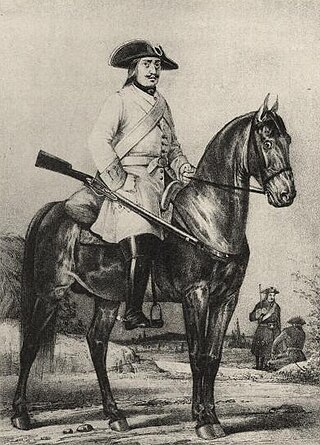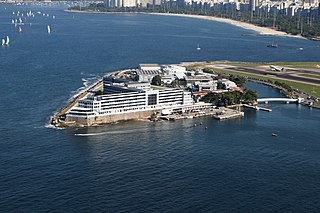
Dragoons were originally a class of mounted infantry, who used horses for mobility, but dismounted to fight on foot. From the early 17th century onward, dragoons were increasingly also employed as conventional cavalry and trained for combat with swords and firearms from horseback. While their use goes back to the late 16th century, dragoon regiments were established in most European armies during the 17th and early 18th centuries; they provided greater mobility than regular infantry but were far less expensive than cavalry.

Manuel I, known as the Fortunate, was King of Portugal from 1495 to 1521. A member of the House of Aviz, Manuel was Duke of Beja and Viseu prior to succeeding his cousin, John II of Portugal, as monarch. Manuel ruled over a period of intensive expansion of the Portuguese Empire owing to the numerous Portuguese discoveries made during his reign. His sponsorship of Vasco da Gama led to the Portuguese discovery of the sea route to India in 1498, resulting in the creation of the Portuguese India Armadas, which guaranteed Portugal's monopoly on the spice trade. Manuel began the Portuguese colonization of the Americas and Portuguese India, and oversaw the establishment of a vast trade empire across Africa and Asia. He was also the first monarch to bear the title: By the Grace of God, King of Portugal and the Algarves, this side and beyond the Sea in Africa, Lord of Guinea and the Conquest, Navigation and Commerce in Ethiopia, Arabia, Persia and India.
A royal family is the immediate family of kings/queens, emirs/emiras, sultans/sultanas, or raja/rani and sometimes their extended family.

The Most Serene House of Braganza, also known as the Brigantine dynasty, is a dynasty of emperors, kings, princes, and dukes of Portuguese origin which reigned in Europe and the Americas.

A royal guard is a group of military bodyguards, soldiers or armed retainers responsible for the protection of a royal family member, such as the emperor or empress, king or queen, or prince or princess. They often are an elite unit of the regular armed forces, or are designated as such, and may maintain special rights or privileges.
Infante, also anglicised as Infant or translated as Prince, is the title and rank given in the Iberian kingdoms of Spain and Portugal to the sons and daughters (infantas) of the king, regardless of age, sometimes with the exception of the heir apparent or heir presumptive to the throne who usually bears a unique princely or ducal title. A woman married to a male infante was accorded the title of infanta if the marriage was dynastically approved, although since 1987 this is no longer automatically the case in Spain. Husbands of born infantas did not obtain the title of infante through marriage, although they were occasionally elevated to the title de gracia at the sovereign's command.

The National Republican Guard or GNR is the national gendarmerie force of Portugal.
Imperial and Royal Highness is a style possessed by someone who either through birth or marriage holds two individual styles, Imperial Highness and Royal Highness. His/Her Imperial Highness is a style used by members of an imperial family to denote imperial – as opposed to royal – status to show that the holder is descended from an Emperor rather than a King or Queen. Holders of the style Imperial Highness generally rank above holders of the style Royal Highness.
The highest hereditary title in the Portuguese nobility. By tradition, there are a total of five royal and seven non-royal dukes in Portugal, out of 28 dukedoms that have ever been created. In the majority of cases, the title of duke was attributed to members of the high nobility, usually relatives of the Portuguese Royal Family, such as the second son of a monarch.

The Naval School is a higher education military academy which aims to train officers for the Brazilian Navy. It is located in Rio de Janeiro, on Villegagnon Island just inside of Guanabara Bay.

The Royal Guard is an independent regiment of the Spanish Armed Forces that is dedicated to the protection of the King of Spain and members of the Spanish royal family. It currently has a strength of 1,500 troops. While the guard does participate in parades and other ceremonial events, it is a fully functional combat unit. Its members are recruited from the ranks of all three branches of the Spanish Armed Forces and receive the same combat training as regular soldiers.

The Order of the Immaculate Conception of Vila Viçosa is a dynastic order of knighthood of the House of Braganza, the former Portuguese Royal Family. The current Grand Master of the Order is Duarte Pio, Duke of Braganza, the Head of the House of Braganza.
The architecture of the Portuguese Renaissance intimately linked to Gothic architecture and gradual in its classical elements. The Manueline style was a transitional style that combined Renaissance and Gothic ornamental elements to buildings that were architectonically closer to Gothic architecture, as is the Isabelline style of Spain. Manueline was succeeded by a brief Early Renaissance phase, closer to Classical canons, followed by the adoption of Mannerist forms. Portuguese Mannerism, specially in secular architecture, is characterised by simplicity in the organisation of façades and relative lack of decoration, being often referred to as Estilo Chão. Even with the arrival of Baroque architecture in the late 17th century, Portuguese architecture continued to use Mannerist forms well into the 18th century.

The Portuguese nobility was a social class enshrined in the laws of the Kingdom of Portugal with specific privileges, prerogatives, obligations and regulations. The nobility ranked immediately after royalty and was itself subdivided into a number of subcategories which included the titled nobility and nobility of blood at the top and civic nobility at the bottom, encompassing a small, but not insignificant proportion of Portugal's citizenry.

The Pantheon of the House of Braganza, also known as the Pantheon of the Braganzas, is the final resting place for many of the members of the House of Braganza, located in the Monastery of São Vicente de Fora in the Alfama district of Lisbon, Portugal. The pantheon's burials have included Portuguese monarchs, Brazilian monarchs, a Romanian monarch, queen consorts of Portugal, and notable Infantes of Portugal, among others.
The Ducal Palace of Vila Viçosa is a royal palace in Portugal, located in the civil parish of Nossa Senhora da Conceição, in the municipality of Vila Viçosa, in the Alentejo, situated about 150 km east of the capital Lisbon. It was for many centuries the seat of the House of Braganza, one of the most important noble houses in Portugal. Braganza was the ruling house of the Kingdom of Portugal from 1640 until 1910, when King Manuel II, titular head of the family, was deposed in the 5 October 1910 Revolution which brought in a Republican government.

The Imperial Guard of the Archers was the ceremonial palace guard of the Brazilian Monarchs from the establishing of the Empire of Brazil in 1822 until the establishment of the republic in that country in 1889. Its members were armed with halberds. The Guard was modeled after the Portuguese Royal Guard of the Archers.
















